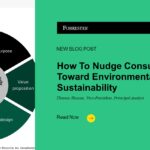What is circular fashion? In 2023, the European Union (EU) adopted the Strategy for Sustainable and Circular Textiles to its Waste Framework Directive, aiming to push the fashion industry towards circularity by minimising waste and maximising resource efficiency. Circular fashion includes a heightened focus on resale platforms, such as Vinted, where consumers can sell and purchase pre-loved items, thus decreasing the amount of clothing in landfills.
What’s Happening Regarding Sustainability in the Fashion Industry?
Our research confirms that price prevails as a priority, as high inflation is still on consumers’ minds in 2024. This leads to cautious spending behaviour with many consumers buying fewer items. Against the backdrop of the cost of living crisis, reselling pre-loved items and purchasing second-hand fashion articles is an attractive alternative to save money and support the environment.
Legislation in support of sustainable fashion
Through the Corporate Sustainability Reporting Directive companies based in/selling into the EU are required to report on their environmental and social impact according to a standardised methodology. Meanwhile, in China, the government has provided incentives for innovation and development in the industry. For example, Mintel has observed that the Pursuer of Excellence in Sustainability, aims to encourage outstanding companies that employ sustainable practices. Both examples show that governments are pushing for change towards sustainable fashion via legislation.
Circular fashion market growth
As pressure on household budgets eases, the focus on sustainability will grow, as awareness of and interest in sustainable practices is already high. In the UK social media posts promoting slow fashion have increased by 29%. Retailers will combine resale, rental, and repair with traditional retail to tap into circular fashion trends and consumer demand.
Consumer Behaviour Regarding Sustainability in Fashion
Meanwhile, for Chinese consumers, sustainable fashion is about more than just the environment. For a successful sustainable fashion narrative in China, brands need to interweave sustainable development with personal wellbeing, family values, and wider social influences to create a deeper resonance.
Sustainable fashion trends vs say-do-gap
Although consumer attitudes towards sustainable fashion seem to mostly be unanimous and positive, Mintel experts found that opinions do not always translate to behaviours. When comparing attitudes towards sustainability with actual changes to behaviour, the value action gap is very wide indeed. Over three-fifths of younger millennials in the UK returned items they had purchased in the last three months, adding to the amount of textiles ending up in landfills. But, what prevents consumers from acting based on their beliefs?
The often hefty price tag is locking consumers out of the sustainable fashion market. Economic factors are challenging the sustainable fashion market, as consumer budgets remain constrained, causing prices to almost always win out. Almost half of UK consumers and 67% of Germans prioritise price over sustainability when making their final purchase decision.
Shoppers who want to follow sustainable trends in fashion find it hard to navigate an industry that is lacking in clarity and direction. Almost seven in ten Britons agree that it requires a lot of effort to know which retailers and brands are actually sustainable. In Germany, buyers find the concept of sustainable fashion inconsistent, especially in connection with fast fashion brands. A lack of transparency causes scepticism that is further fuelled by greenwashing allegations that make it hard for consumers to put their trust in brands. To promote environmental responsibility, brands need to:
- make it easier for consumers to make sustainable choices when buying fashion articles
- communicate their eco-friendly efforts transparently, and provide evidence for their claims.
Paving the Way Forward with Circular Fashion
Fashion marketplaces to support the circular economy
The rise of online fashion marketplaces and second-hand retailers is a result of sustainable fashion trends and high inflation. Ongoing cost of living pressures have led consumers to adopt more conscientious shopping behaviours, for example, buying fewer items, selling unworn pieces and opting for second-hand alternatives. Resale platforms, such as Vinted, provide the perfect way of combining bargains with more eco-friendly shopping behaviours, as sustainable production comes with a higher price tag, causing over two-thirds of Germans to look for more affordable eco-friendly products.

Vinted is one of the major fashion marketplaces offering consumers a platform where they can sell and buy pre-loved items. Source: vinted.co.uk
Price remains more of a priority than sustainability when buyers are made to choose between the two. Particularly, younger consumers continue to be keen fast fashion shoppers due to their often more limited budget. This perfectly positions fashion marketplaces as an affordable way to act sustainably.
Circular fashion trends on social media
There has been a 70% rise in social media posts that mentioned preloved fashion over the last 6 months. Social media has long been a source of information and inspiration when it comes to fashion, with especially younger consumers following influencer trends and reviews when making a purchase decision. Social media is also helping re-energise brands that have been around for a while. Half of Gen Z think that vintage fashion is representative of a better time, signalling an opportunity for brands to tap into Gen Z’s nostalgia and bring back iconic styles from the past.
How Can Brands Embrace Circular Fashion Trends?
While second-hand shops and fashion marketplaces rely on consumers’ own initiative regarding planetary health, there is also scope for more seamless links between retailers and circular services such as repair and rental.
For example, Uniqlo offers repair services in certain US stores. The brand is also investing in visual presentation and staff training to make the service more appealing, while promoting sustainability. Moving forward, companies will explore additional circular business models like repair and remake to minimise waste and resource use.
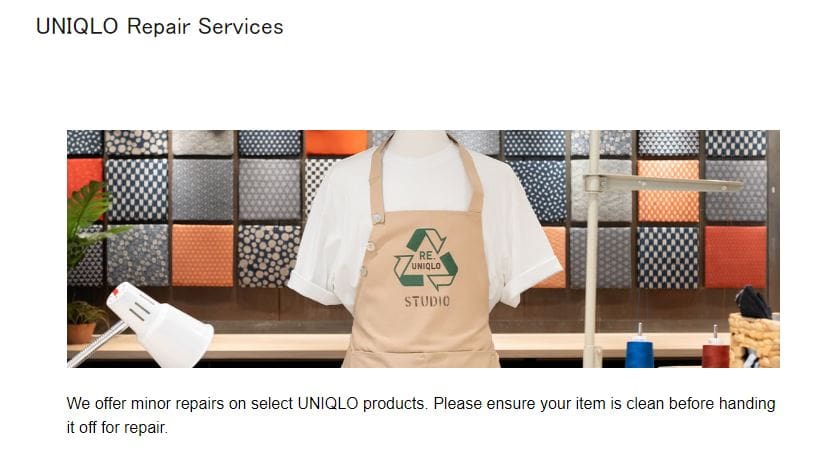
Uniqlo offers repair services in select US stores to minimise waste. Source: us.uniqlo.com
With the rise in sustainable fashion trends, more brands are entering the resale market. Highlighting the resale value or offering options to resell products within a retailer’s website can provide a new perspective on value. For example, German brand hessnatur, which is already marketed as a sustainable fashion line, buys back its own products, categorises their condition and resells them, making it easier for customers to view fashion shopping as a closed circle.
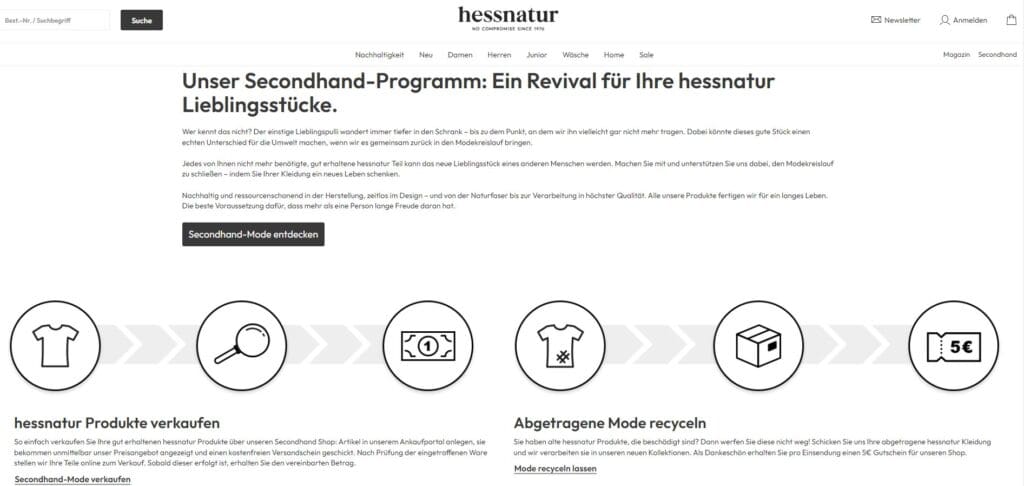
hessnatur offers customers a circular fashion loop where they can sell their pre-loved hessnatur items or buy second-hand articles. Source: hessnaturs.com/de/secondhand.
3. Brick-and-Mortar Shops
Despite the ecommerce acceleration brought on by the pandemic, most consumers still prefer to shop in brick-and-mortar stores to touch, see and try on items in person. Bringing circular offerings to where the consumer is, is therefore vital. This may be even more relevant when purchasing second-hand or renting an item, as consumers likely want to make sure they are getting an item in good condition.
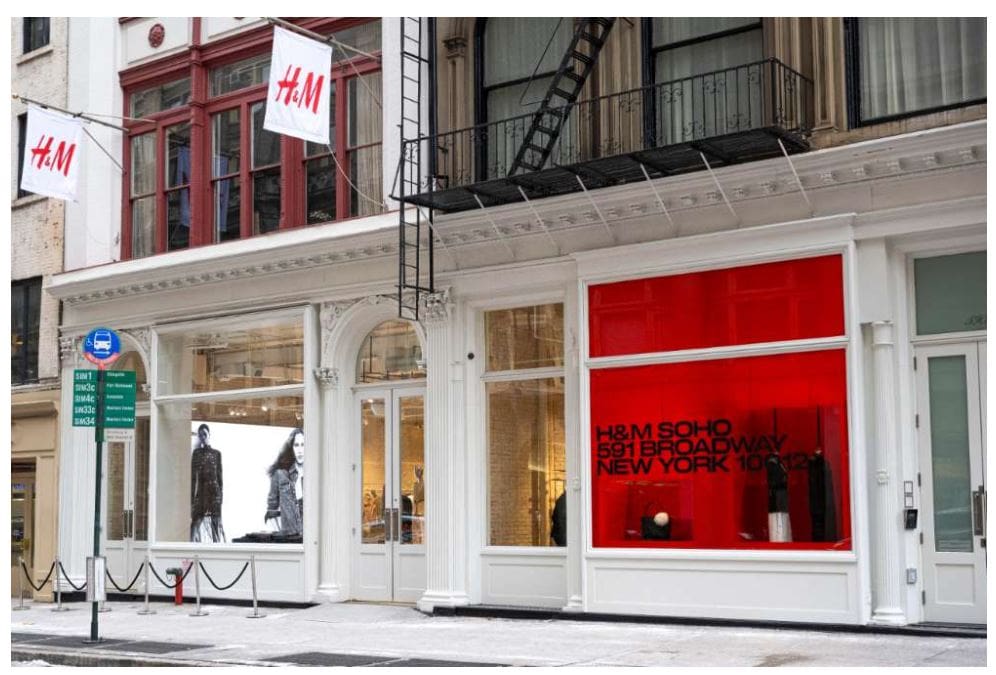
For example, H&M has opened a destination store in New York City for pre-loved items. Source: about.hm.com
With growing consumer awareness of fast fashion’s environmental toll, there’s a rising demand for more sustainable shopping practices. Almost 60% of Germans expect companies to address sustainability concerns – and looking at textile waste, circularity is becoming a crucial aspect of sustainability. With consumers agreeing that companies need to take on more responsibility when it comes to environmental concerns, making it easier for consumers to be circular will be key. Fashion brands can increase awareness of recycled materials used in clothes and encourage consumers to buy them by offering them at a cheaper price point. As investment in textile recycling increases, this will bring down the costs, driving retailers to use these materials as an alternative for their overall collections rather than just for capsule pieces.
How Sustainable Fashion Trends are Driving Innovation
Textile innovation
Fashion brands are switching to natural organic fabrics, environmentally friendly viscose, and recyclable and bio-based materials to achieve a green transition. Apart from these more established eco-friendly fabrics, new materials and technologies also help fashion brands become more sustainable. For example, Chinese brand Aimer uses seaweed fibre to develop high-end marine-based underwear and sleepwear that is naturally antibacterial and anti-mite, comfortable to wear as well as environmentally friendly.
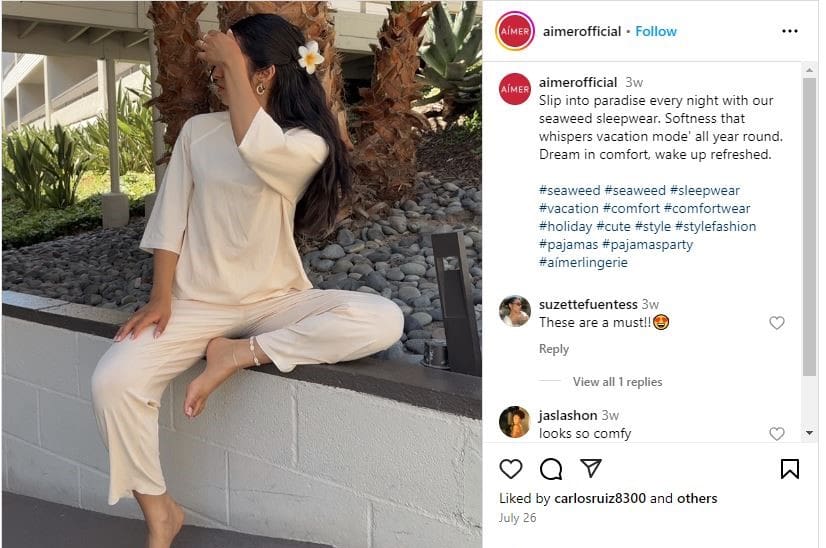
Aimer introduces innovative fabrics made from seaweed fibre. Source: instagram.com/aimerofficial/.
How technology can support circular fashion
While resale platforms provide an excellent opportunity to give new life to items, the success of a sale isn’t always guaranteed, depending on the quality of the items being resold or the imbalance of supply and demand. Using technology can help deal with an oversupply of pre-loved items. For example, The Autosort for Circular Textiles project led by the UK Fashion and Textile Association (UKFT) is developing a new framework to recycle clothes not suitable for resale using optical scanning, robotics, and AI to streamline the process. AI is also being used by brands such as H&M to analyse store receipts and returns so they can adjust quantities of items needed for stores, thereby reducing the chances of having high quantities of unsold stock.
Looking Ahead With Mintel
We’ve seen that there are many ways in which consumers and businesses can act to accelerate the move towards sustainability in the fashion industry. The purchase and reselling of pre-loved fashion items is the most straightforward way for consumers to be eco-friendly. Fashion marketplaces and brick-and-mortar second-hand shops, which are enjoying a new wave of popularity, can help support consumers in their mission.
The fashion industry can leverage the demand for circular fashion as well by tapping into the resale market and setting up their own communities and digital platforms for consumers to buy and sell what they previously bought from the brand. Another way to support the circular economy is by offering repair or rental services as an alternative to buying new items. Investment in innovation – in textiles and technology – will also be vital to make the fashion industry more sustainable long-term.
For an in-depth analysis of sustainability and consumers, have a look at Mintel’s new Global Outlook on Sustainability: A Consumer Study 2024-25.
Never miss out on up-to-date market and consumer insights, delivered directly to your inbox with Mintel’s Spotlight Newsletter – Sign up below.
Sign Up to Spotlight here


